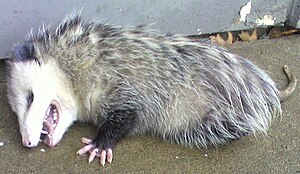مردهنمایی


مردهنمایی (به انگلیسی: feigning death, apparent death) که در زبان عامیانه به عنوان موشمردگی[۱]، بهمردنزدن یا وانمودسازی مرگ شناخته میشود، رفتاری است که در آن، جانوران ظاهر مرده به خود میگیرند. این یک حالت بیحرکت است که اغلب با حمله یک شکارگر ایجاد میشود و میتواند در طیف گستردهای از جانوران از حشرات و سختپوستان گرفته تا پستانداران، پرندگان، خزندگان، دوزیستان و ماهیان یافت شود.[۲][۳] مردهنمایی در انگلیسی با عبارتهایی چون رنگپریدگی (تناتوز)، هیپنوتیزم جانوری، کاتاتونی بیحرکتی، یا بیحرکتی تونیک نیز نامیده میشود، که مورد آخر در مقالات علمی دربارهٔ این موضوع ترجیح داده میشود.[۲][۴][۵][۶] مردهنمایی جدا از رفتار یخزدگی در برخی از جانوران است.[۲][۴]
بیحرکتی تونیک در برابر یخزدگی
[ویرایش]بیحرکتی تونیک (و در نتیجه "تظاهر به مرگ") با واکنش " انجماد " در جانوران متفاوت است.[۲] یک آهو در چراغهای نورافکن و یک صاریغ در حال «مردهنمایی»، نمونههای رایجی از جانوران هستند که به ترتیب یخزدگی و مردهنمایی میکنند. یخزدگی در ابتدای برهمکنش شکارچی و طعمه زمانی رخ میدهد که طعمه تهدید را تشخیص و شناسایی میکند، اما شکارچی هنوز طعمه را ندیدهاست.[۲] از آنجایی که یخزدگی پیش از شناسایی رخ میدهد و برای استتار بهتر طعمه و جلوگیری از حمله شکارچی استفاده میشود، سازوکار دفاعی اولیه محسوب میشود.[۴]
نگارخانه
[ویرایش]-
یک صاغرمار آمریکایی که مردهنمایی میکند و یک وزغ را پس میزند
-
یک عنکبوت بیوه قهوهای پس از تکان خوردن تار خود دست به رفتار رنگپریدگی میشود
-
سیچلیدهای سردهٔ Nimbochromis از رفتار رنگپریدگی به عنوان نوعی تقلید تهاجمی استفاده میکنند و برای جذب طعمه، مردهنمایی میکنند.
منابع
[ویرایش]- ↑ «تحقیق تازه؛ جانداران برای چه مدت خودشان را به «موشمردگی» میزنند؟». euronews. ۲۰۲۰-۰۷-۰۸. دریافتشده در ۲۰۲۴-۰۱-۰۷.
- ↑ ۲٫۰ ۲٫۱ ۲٫۲ ۲٫۳ ۲٫۴ Humphreys, Rosalind K.; Ruxton, Graeme D. (2018-01-15). "A review of thanatosis (death feigning) as an anti-predator behaviour". Behavioral Ecology and Sociobiology (به انگلیسی). 72 (2): 22. doi:10.1007/s00265-017-2436-8. ISSN 1432-0762. PMC 5769822. PMID 29386702. خطای یادکرد: برچسب
<ref>نامعتبر؛ نام «:0» چندین بار با محتوای متفاوت تعریف شده است. (صفحهٔ راهنما را مطالعه کنید.). - ↑ Miyatake, T.; Katayama, K.; Takeda, Y.; Nakashima, A.; Sugita, A.; Mizumoto, M. (2004-11-07). "Is death–feigning adaptive? Heritable variation in fitness difference of death–feigning behaviour". Proceedings of the Royal Society of London. Series B: Biological Sciences (به انگلیسی). 271 (1554): 2293–2296. doi:10.1098/rspb.2004.2858. ISSN 0962-8452. PMC 1691851. PMID 15539355.
- ↑ ۴٫۰ ۴٫۱ ۴٫۲ خطای یادکرد: خطای یادکرد:برچسب
<ref> غیرمجاز؛ متنی برای یادکردهای با نام:1وارد نشده است. (صفحهٔ راهنما را مطالعه کنید.). - ↑ Rogers, Stephen M.; Simpson, Stephen J. (2014). "Thanatosis". Current Biology (به انگلیسی). 24 (21): R1031–R1033. doi:10.1016/j.cub.2014.08.051. PMID 25517363.
- ↑ Rusinova, E. V.; Davydov, V. I. (2010-05-21). "Dynamics of Changes in Electrical Activity in the Rabbit Cerebral Cortex during Sequential Sessions of "Animal Hypnosis"". Neuroscience and Behavioral Physiology. 40 (5): 471–478. doi:10.1007/s11055-010-9283-7. ISSN 0097-0549. PMID 20490695.
Text is available under the CC BY-SA 4.0 license; additional terms may apply.
Images, videos and audio are available under their respective licenses.



